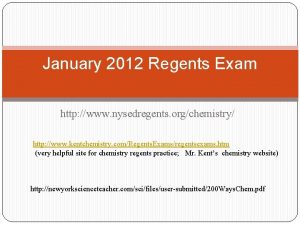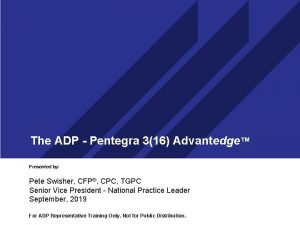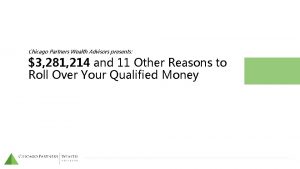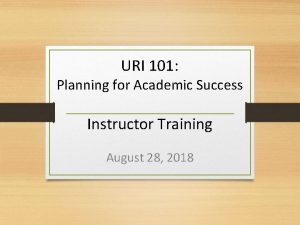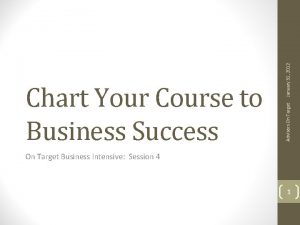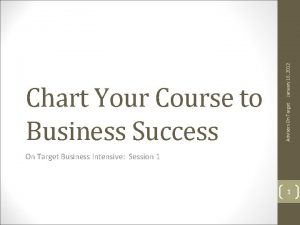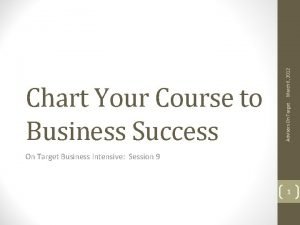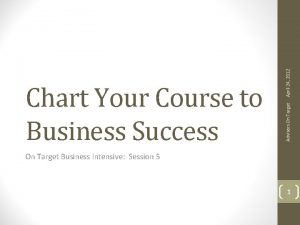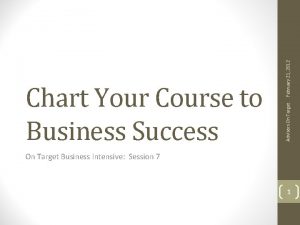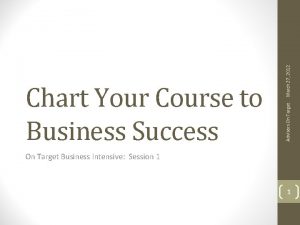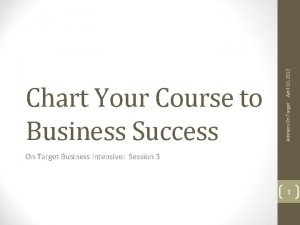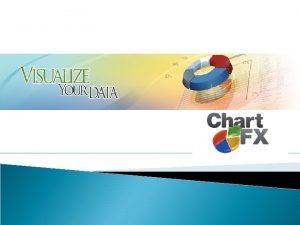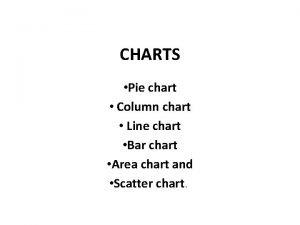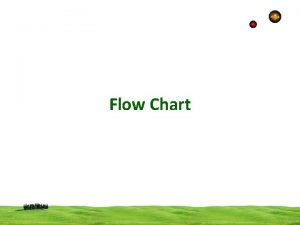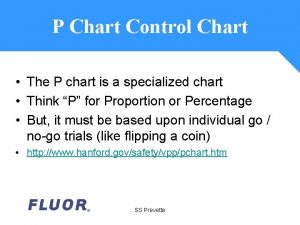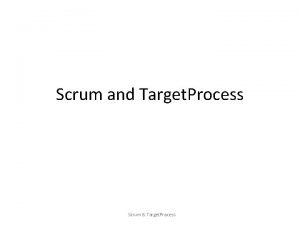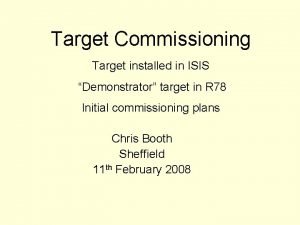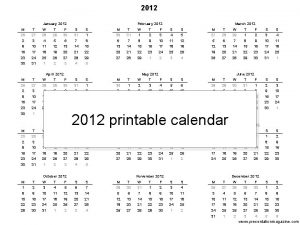January 31 2012 Advisors On Target Chart Your




































- Slides: 36

January 31, 2012 Advisors On Target Chart Your Course to Business Success On Target Business Intensive: Session 4 1

Homework so far • Session 1 • Create a working draft of your Mission Statement • Create a working draft of your 1 and 5 year Vision • Answer the 10 questions on the handout • Session 2 • Review your own financial statements and chart of accounts with what you learned in Session 2 • Session 3 • Create a budget for 2012 • If you already have a budget, review and revise as needed • Use the cashflow projection model (at the bottom of the budget tool) 2

Homework continued • Session 4 • Determine your breakeven point for your 2012 budget • Annual • For the month of February 2012 • Additional activities • Values Exercise • Business Diagnostic Assessment 3

Questions about Budget Process? 4

Recap: How to Use your Budget • Incorporate Budget into Quick. Books • Monitor Monthly & YTD Progress • Know what key numbers you need to hit • • Income Profit Margins Hours/Personnel Leads • Make management decisions to achieve plan • Identify Action Steps for upcoming month

Break Even Why Every Business Owner Needs to Know It 6

BEST PRACTICE GUIDE : Breakeven Sales Overhead Expenses* Breakeven Sales = _____________ Gross Profit Margin Calculate by week, month, or year to manage your business effectively and keep a positive bottom line *Include Variable Costs, Overhead Costs and “Other Costs” if critical to business survival

Annual Budget Example Revenue $500, 000 Direct Costs ($275, 000) 55% Gross Profit $225, 000 45% Variable Expenses ($25, 000) 5% Overhead Expenses ($150, 000) 30% Net Operating Profit $50, 000 10%

Annual Break-Even Revenue Variable Expenses Overhead Expenses Total Overhead Expenses Divided by GP% Break-Even Revenue $25, 000 + $150, 000 $175, 000 45% $388, 889

Monthly Budget Example Revenue $48, 000 Direct Costs ($26, 400) Gross Profit $21, 600 Variable Expenses ($2, 400) Overhead Expenses ($14, 400) Net Operating Profit $4, 800 55% 45% 5% 30% 10%

Monthly Budget Break-Even Variable Expenses $2, 400 Overhead Expenses $14, 400 Total $16, 800 Divided by GP% Break-Even Revenue 45% $37, 333

Calculating Break-Even Hours • Monthly Budget $48, 000 • Based on 6 painters @ 160 hours each • Total Budget Hours 960 • Projected Sales Price per hour $50 (including materials) • If Break-Even Revenue is $37, 333 • Break-Even Hours are 747 for month • (approx 174 hours per week)

What about other expenses? • Take into account other expenses that don’t hit the Profit and Loss • Owner Draws/Loans to Shareholders • Loan Payments • Credit Card Payments not included in monthly operating expenses

Changed Break-Even Variable Expenses Overhead Expenses Vehicle Loan Total $2, 400 $14, 400 $750 $17, 550 Divided by GP% Break-Even Revenue Break-Even Hours are now 780 for the month 45% $39, 000

What if your GP% decreases? Variable Expenses Overhead Expenses Vehicle Loan Total $2, 400 $14, 400 $750 $17, 550 Divided by GP% Break-Even Revenue Break-Even just increased by almost $5, 000! 40% $43, 875

Using Break-Even Analysis to Add Infrastructure How much more revenue do you need for new overhead to at least pay for itself?

Adding a new overhead position Sales Salary Payroll Tax/WC Benefits Vehicle Expense Cell Phone Total Divided by GP% Break-Even $40, 000 $5, 200 $3, 900 $6, 000 $600 $55, 700 45% $123, 778

Knowledge is power • Knowing your numbers and learning how even small but timely changes affect your profitability increase your opportunities for success in any economy.

Marketing Your Business

Marketing • Marketing is a key component of your business plan and achieving the results you are aiming for • A Market Analysis shows your understanding of the market, your customers and your competitors. • A Marketing Plan to present the strategies to develop the leads for achieving the sales forecasts you are projecting.

Steps to a marketing plan • • • Define your market Analyze your market and industry Identify your marketing and sales strategies Describe your advertising and promotional activities Your marketing plan is a key component of your business plan

Market Research – Why do it? • • Obtain data about your geographic market Obtain data about your customers and potential customers Obtain data about your competitors Ensure you are on the right track with your marketing efforts

How to do Market Research • Primary – Do your own research • Identify competitors via Yellow Pages or online • Conduct surveys • Do focus group interviews • Secondary – Use other people’s research • Published Information: Industry profiles, trade journals, newspapers, magazines, census data etc. • Sources: Trade Associations, Vendors, Chamber of Commerce

Document your research • Show statistics, numbers, and sources. • Your marketing plan will become the basis, for your sales projection.

Market Analysis - Economics Facts about your industry Total size of your market and Percentage share you have Current demand in target market Growth history Trends in target market — growth trends, trends in consumer preferences, and trends in product development • Growth potential and opportunity for a business of your size • Barriers to entry for new competitors • Other factors that can affect your business • Change in technology • Government regulations • Changing economy • Change in your industry • • •

Products and Services • Features - Tangible • What does your product/service do? • What is special about it? • Benefits - Emotional • What does it do for your customer • After sale services • Warranty, service contract, support, follow-up • What is your Unique Core Differentiator? ? ? • What is really different about you and what does that mean for your customer • Try to think of things that your competitors can’t or don’t say

Who are your Customers? • Identify your customers • Characteristics • Geographic Location • • More than one customer group? Are there intermediaries? Identify most important groups Construct demographic profiles for each

Demographic Profile Consumers • • Age Gender Location Income level Social class/occupation Education Other • Home Value, etc.

Demographic Profile – Business Customers • • • Industry (or niche) Location Size of firm Quality/technology/price preferences Other

Competitors • Who are your competitors? • Products/services • Companies • List your major competitors • Do they compete in all areas of your business or just for specific customers or services? • What are key competitive factors? • Analyze your strengths and weaknesses

What is your niche? • Your unique corner of the market

Marketing Strategy • Promotion • • • How do you get the word out? Advertising • Media • Frequency • Effectiveness Other Marketing Methods • Networking • Home Shows • Website/Online/Social Media Customer Communication Plan Marketing and Advertising Budget Pricing Strategy

Distribution Channels • How do you sell your products or services? • • • Retail Direct (mail order, internet) Wholesale Your own sales force Agents Independent reps • Has your marketing strategy proven effective? • Do you need to make any changes or additions to current strategies?

Location • Here in the Marketing Plan section, analyze your location as it affects your customers. • If customers come to your place of business: • Is it convenient? Parking? Interior spaces? Not out of the way? • Is it consistent with your image? • Is it what customers want and expect? • Where is the competition located? Is it better for you to be near them (like car dealers or fast-food restaurants) or distant (like convenience food stores)?

Sales Forecast • Provide a month by month sales forecast for the next year based on • • Historical Sales Market Research Seasonal Flow Growth Assumptions • Consider providing two forecasts • Best case • Worst case

Homework 1. 2. Define Target Market Do a Competition Analysis
 Kent chemistry reference table
Kent chemistry reference table January 2012 chemistry regents
January 2012 chemistry regents January 2018 chemistry regents answers
January 2018 chemistry regents answers January 2012
January 2012 Primary target market and secondary target market
Primary target market and secondary target market Give us your hungry your tired your poor
Give us your hungry your tired your poor Adp doc vault
Adp doc vault Robert kwong uf
Robert kwong uf Silver fox advisors
Silver fox advisors Personal branding for financial advisors
Personal branding for financial advisors Iii offshore advisors
Iii offshore advisors Chicago partners wealth advisors
Chicago partners wealth advisors Acu academic advisors
Acu academic advisors Statewide health insurance benefits advisors
Statewide health insurance benefits advisors Relational advisors
Relational advisors Leoni corporate advisors
Leoni corporate advisors Agec pima
Agec pima Uri academic advisors
Uri academic advisors Karatzas marine advisors
Karatzas marine advisors Job market for certified crop advisors
Job market for certified crop advisors Logista advisors
Logista advisors Aboriginal heritage act
Aboriginal heritage act Emerging technology advisors
Emerging technology advisors Independent energy advisors
Independent energy advisors Noanet fiber map
Noanet fiber map Top commodity trading advisors
Top commodity trading advisors Franchise mergers and acquisitions
Franchise mergers and acquisitions Led lighting advisors
Led lighting advisors Ask the advisors
Ask the advisors Fidelity advisor 529
Fidelity advisor 529 Premier capital advisors
Premier capital advisors Southwark young advisors
Southwark young advisors Ivy tech indianapolis advising
Ivy tech indianapolis advising Uf study abroad advisors
Uf study abroad advisors Utsa military affairs
Utsa military affairs Rei finance advisors
Rei finance advisors Senior market advisors
Senior market advisors
